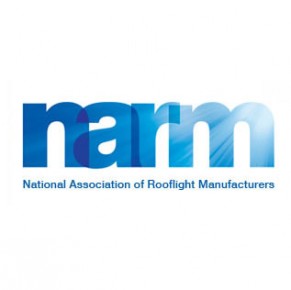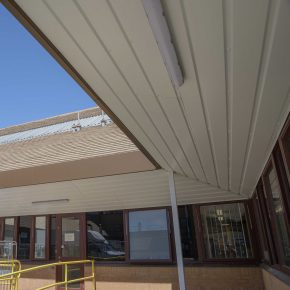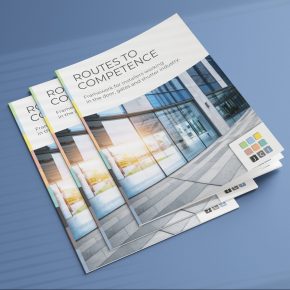
Establishing the optimum rooflight area with NARM
NARM, The National Association of Rooflight Manufacturers, have been explaining how minor differences in rooflight area can make a substantial impact on light levels and energy usage, courtesy of its Technical Committee.
With it being common knowledge that specified rooflights save energy and lower CO2 emissions, this also makes them a vital component to meeting Part L of The Building Regulations covering the Conservation of Fuel & Power and the equivalent regional regulations.
Research has shown minimal losses in thermal insulation are massively offset by energy savings, leading to a lessened demand for electric lighting and, generally speaking, the larger the rooflight area, the more savings could be potentially made. There is, however, a limit before overheating could manifest as an issue, so an optimum area has to be identified.
A specific solution never exists in terms of rooflight area, with judgement essential based on whatever the project may be. However, the example (click here to see) shows how data gathered can be used to inform a decision. NARM can provide data for varying building locations, for rooflights with varying degrees of light transmission and for different daily time windows.
The first consideration in establishing rooflight area is the use of the building; for example, in retail and manufacturing areas, the recommended light level* is 500 Lux.
Establishing the appropriate rooflight area to achieve the desired light level is next; the larger the rooflight area, the increased amount of hours every year the necessary light level will be natural light. This is a vital factor affecting energy and emissions reductions, as there is no need for electric lighting during these hours.
The graph in the link shows a single storey building in London, between 6am and 6pm daily, with rooflights providing 50% light transmission. It shows, as the rooflight area across the bottom of the graph increases, the length of time a given illumination level is achieved, is extended.
So a building which requires 500 Lux, the yellow line shows with 10% rooflights, 500 lux would be achieved for approximately 2000 hours (46% of the working year).
For further information, please contact NARM using the contact details on our website, where you will be directed to the appropriate person.
Click here to visit The Rooflight Association's website
Visit Supplier's page
Latest news

26th April 2024
Alumasc Skyline and Rainwater package specified at Weston-super-Mare Hospital
A package of products from Alumasc Water Management Solutions (AWMS) has been used for the external refurbishment of the roofline at Weston General Hospital in Weston-Super-Mare.
Posted in Aluminium Products, Articles, Building Industry News, Building Products & Structures, Building Services, Building Systems, Case Studies, Cladding, Drainage Services, Drainage, Guttering, Soffits & Fascias, Fascias, Restoration & Refurbishment, Retrofit & Renovation, Roofs, Walls
26th April 2024
Hush Acoustics optimises fleet operations by securing FORS Gold accreditation
Hush Acoustics has invested in the safety and sustainability of its commercial vehicle fleet by achieving Gold status in the Fleet Operator Recognition Scheme (FORS).
Posted in Acoustics, Noise & Vibration Control, Articles, Building Industry News, Building Products & Structures, Building Regulations & Accreditations, Building Services, Ceilings, Facility Management & Building Services, Floors, Health & Safety, Insulation, Restoration & Refurbishment, Retrofit & Renovation, Site Preparation, Sustainability & Energy Efficiency, Walls, Waste Management & Recycling
26th April 2024
Safeguard Europe: Penetrating damp - how to diagnose the damage
As Safeguard gets ready to deliver another informative session of one of its most popular webinars, the company outlines some of the most common reasons for rain penetration through brickwork.
Posted in Articles, Bricks & Blocks, Building Industry Events, Building Industry News, Building Products & Structures, Building Services, Continuing Professional Development (CPD's), Damp & Waterproofing, Facility Management & Building Services, Information Technology, Posts, Render, Restoration & Refurbishment, Retrofit & Renovation, Seminars, Training, Walls
25th April 2024
ADSA: Competence Initiative Makes Progress
The Joint Competency Initiative (JCI), in which the Automatic Door Suppliers Association (ADSA) is involved, is finalising its first framework for installers within the door, gates and shutter industry.
Posted in Access Control & Door Entry Systems, Architectural Ironmongery, Articles, Building Associations & Institutes, Building Industry Events, Building Industry News, Building Products & Structures, Building Regulations & Accreditations, Building Services, Continuing Professional Development (CPD's), Doors, Facility Management & Building Services, Health & Safety, Innovations & New Products, Publications, Research & Materials Testing, Restoration & Refurbishment, Retrofit & Renovation, Security and Fire Protection, Site Preparation
 Sign up:
Sign up: